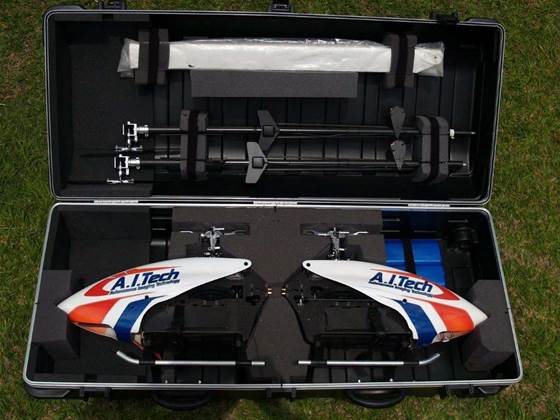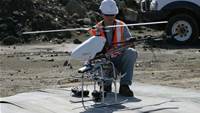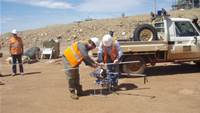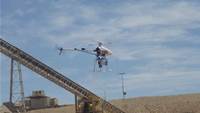Utilities, mining and resources companies are turning to unmanned aerial vehicles (UAVs) to avoid downtime during infrastructure surveys and assessments.

Preliminary mine tower inspections typically require plants to be shut down to stop "steam, heat and possibly toxins" from escaping, according to Cyber Technology project manager Joshua Portlock.
"Normally the process would be to fully shut down the plant ... then they have to get it all certified safe for people to climb and set up all their rigging," Portlock says.
"The downtime expense on those towers is extraordinary."
Portlock says the vendor's CyberQuad UAV has been used to conduct "several ... external inspections" of operating mine towers.
"It's not dangerous for the CyberQuad to be flying near a hot tower as long as you're keeping it within its temperature limits, and we've got alerts and warnings for that," he says.
"We fly around outside or up and down in strips, and take ... lateral photos to build up a vertical mosaic of the whole tower.
"From that imagery, the inspection crew can identify any major concerns or areas that need a closer inspection or a possible repair.
"Once they build up that plan based on that preliminary inspection, they can much more cost effectively shut [the mine tower] down and send people up to get the job done quicker, in and out."
Other operators are finding success in environmental monitoring applications on- and offshore, and monitoring for any subsidence above or adjacent to underground mines.
"If you're operating at sea - LNG is a classic example - how do you continuously monitor what's happening around the platform?" UAVs Australia's Mark Stevens says.
"It's very easy to fly periodically a UAV mission around those platforms and then using software [to] do a comparative analysis of the environmental state, either day-to-day or week-to-week, and ... use that to support environmental work that you're doing to minimise any impact those operations may have."
Other UAV use cases
Thermal monitoring is another emerging application. Hot spots can form in coal stock and refuse piles due to a combination of ambient factors - for example, sunlight and oxygen levels.
"We're about to undertake a project up north [where the customer] already has an idea of where coal is burning underground in the spoil, and they want us to fly over with a thermal [camera] and monitor those on a weekly basis to see whether or not their new process of extinguishing that is working," HELImetrex's Ray Gillinder says.
Several pit mapping applications for highwalls, pit walls and development faces (before they are blasted) are beginning to emerge.
Gillinder says highwall mapping can be performed with a downward-pointed camera trained from a UAV.
Likewise, Adam Technology managing director Jason Birch is seeing "a couple of customers" use UAVs they have bought for a different purpose to expand into pitwall mapping.
"Most of our customers just take photos across the pit from the opposite side using terrestrial photogrammetry, but I know a couple of customers [using a UAV], especially where subsidence is occurring," Birch says.
Several operators and surveyors alike see some interest in LiDAR payloads for UAVs. According to the CSIRO, "LiDAR uses laser pulses to generate 3D structural data for terrain and landscape features".
"Payloads in future are going to change," graduate mine surveyor Kiernan Smithson says. "A lot of people now are looking into LiDAR, trying to get operational UAVs running with LiDAR."
HELImetrex's Gillinder is also seeing the trend towards LiDAR, though he cautions that its weight currently discounts it from being carried by anything but large fixed-wing aircraft.
He also says processing times for LiDAR - compared to the current system of offloading UAV-captured data in the field into a software program for analysis - make it a tough proposition.
"The client usually wants that data very quickly," Gillinder says. "We pretty much process onsite in the field. Over a set of stockpiles we can pretty much have that processed inside two hours after capture."
Plug-and-play?
Future applications envisioned by other industry players include shared UAVs and plug-and-play remote operation.
"I know of one company that's ... looking to have fixed wing UAVs that can be deployed from one site, like an airstrip, that cover multiple mines - for example, in the Hunter Valley or Bowen Basin," Smithson says.
A.I. Tech's Kevin Lunn sees a future where a customer is given a boxed UAV that they plug into a wall.
"When it needs to be used it'll be pulled out, blades unfolded and turned on," he says.
"We'll hook into it from [our] office and do the whole flight from our office in Perth or wherever we are. The aircraft will do its job , it'll come back, land and then be rolled back into the box, put back into a container and plugged in again until next time".
Read on to find out how UAVs could transport spare parts to offshore platforms and regulatory roadblacks to such a service.
Last month, ABC News reported that UAVs Australia planned to offer to deliver spare parts to and from offshore liquefied natural gas (LNG) platforms using drones.
The company expects to trial UAVs to deliver spare parts, up to a weight of 30 kilograms, to remote sites "in the next three months or so".
"We have been asked to do a trial of the delivery of stuff to remote mining settlements and at sea to mining platforms, but that is at the extreme edge of the current capability envelope [for UAVs]," commercial director Mark Stevens says.
"We'll certainly do that in the next few months but I think it would be fair to say that's a developmental application of the technology rather than an existing capability."
The parts delivery proposal raised eyebrows when it was reported - and at least some of the more established players don't see it holding much weight, citing payload capability and civil aviation regulations as key roadblocks.
"People get so carried away with a UAV," A.I. Tech director Kevin Lunn says.
"Let's keep in mind the main [purpose of a] UAV is it's deployable from almost anywhere, and it's very fast and efficient.
"You don't need to have autonomous flight out to LNG plant and back. I don't see that as really being a viable option at this stage.
"I imagine you'll see that in commercial aircraft before you ever see it in private operations, where you'll actually have freighters flying freight around the world autonomously.
"You've got to [evaluate] how big do I need to be? Am I a UAV or better off moving into a full size aircraft? Because at the end of the day full sized aircraft really aren't that expensive."
HELImetrex CEO Ray Gillinder points to potential regulatory difficulties in ferrying large payloads. He says CASA licenses payloads under 25 kilograms without certification.
CASA concerns
Current civil aviation and safety regulations (CASRs) in Australia that govern the operation of unmanned aerial systems (UAS) date back to July 2002.
The Civil Aviation and Safety Authority (CASA) kicked off a high-priority project in July last year to review the decade-old rules in light of the significant ramp-up in activity around UAV use.
"The project objective is to provide more comprehensive guidance to Industry on the regulatory requirements and approval processes for commercial operation of UAS in Australia," CASA says.
"The guidance will consider the long term integration of UAS into normal aviation operations in all classes of airspace."
The revision of rules around UAVs is well understood by the sector's key players.
"You've got to keep in mind that CASA doesn't want every man and his dog out there flying UAVs in airspace they have no knowledge of whatsoever," A.I. Tech's Kevin Lunn says.
"Backyard modellers can go buy these things from hobby shops and fly them within a kilometre of Perth airport and no one's there to be able to look after it. That's why CASA are jumping on it from big heights at the moment.
"They want people like us doing what we do because we understand where full size aircraft are, and how the structure works in the general aviation industry."
Most UAV operators interviewed by iTnews approached civil aviation regulation in the same manner as existing commercial air operators.
"CASA has set the bar very high which we support, so we've similarly established an excessive level of governance, safety and administration, just so that they're comfortable with what we're doing," UAVs Australia's Mark Stevens says.
Cyber Technology's Joshua Portlock says his firm's chief UAV operator is a board member of CASA's committee for unmanned vehicles, "so he's got a good working relationship [with them]."
UAV operators require a controller's certificate and operator's certificate in order to sell UAV services.
"[UAV] 'pilots' require general aviation knowledge in line with a private pilot's licence, and specific UA skills," CASA notes in a fact sheet. "Additional ratings include a flight radio operator's licence, and experience on the type of [UAV] operated."
Such regulation makes it less likely that miners will buy train onsite personnel to pilot UAVs. Rather they will buy those skills in on an as-needed basis, according to Adam Technology's Jason Birch.
"I think in the beginning we envisaged that mine sites would buy the UAV and operate it themselves, but I think with the new emphasis that CASA is placing on certifications, it's probably not realistic anymore for mine sites to do everything themselves," Birch says.
HELImetrex's Ray Gillinder concurs: "[Piloting UAVs] is a professional in their own field".
This article is part of a special investigation into the use of UAVs in Australian mines. Stay tuned to iTnews tomorrow for the final installment.






_(22).jpg&h=140&w=231&c=1&s=0)

_(20).jpg&h=140&w=231&c=1&s=0)






 iTnews Executive Retreat - Security Leaders Edition
iTnews Executive Retreat - Security Leaders Edition











_(1).jpg&h=140&w=231&c=1&s=0)



